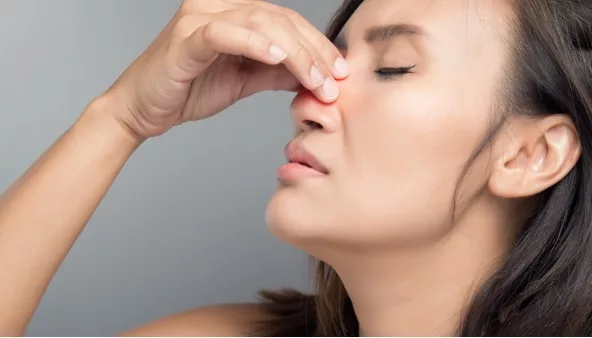What Is Type 2 Inflammation?
Each of our bodies has an immune system that helps protect us from invaders, such as viruses, bacteria, and other harmful things that could make us sick.1 The immune system aims to keep us healthy by detecting and eliminating these invaders.1 One important part of the immune system is our type 2 immune response, which occurs when the body senses certain kinds of infections.1
But, in some people’s bodies, this immune response occurs when there is no infection, which can lead to the body damaging itself. This overactive response is called type 2 inflammation.1
Type 2 inflammation contributes to many different conditions including allergic conditions.1 Type 2 inflammation can play an underlying role in conditions such as asthma, eczema (also known as atopic dermatitis or AD), nasal polyps (more specifically known as chronic rhinosinusitis with nasal polyposis or CRSwNP), eosinophilic esophagitis (EoE), prurigo nodularis (PN), and certain types of food allergies.1 Around the globe, the number of people affected by type 2 inflammatory conditions is increasing – with asthma, eczema, and nasal polyps, currently affecting up to 18%, 10%, and 3% respectively.2
While it’s possible to only have one of these conditions, people frequently have more than one disease driven in part by type 2 inflammation.1 In the United States, asthma occurs in up to 65% of people with CRSwNP and in 31% of people with AD.3,4
Why Is It Important to Know If Type 2 Inflammation Impacts Me or Someone I Care For?

Disease Burden
Disease burden is an underestimated struggle for people living with conditions caused in part by type 2 inflammation.2,5,6 Conditions such as asthma and nasal polyps can be challenging as they often have “invisible” symptoms like trouble breathing, a stuffy nose, or can be more visible like a runny nose.7 As a result, people living with these conditions may not receive the understanding or support they require from primary care doctors, family, friends, or society.2
Challenges with allergic conditions may also impair someone’s senses.8 For example, nasal polyps can decrease the sense of taste and smell.8 Someone with nasal polyps may not be able to smell a fire or gas leak. This can be dangerous.8
On the other hand, some type 2 inflammatory conditions can be quite visual – such as dark circles under the eyes (called “allergic shiners”), excessive mouth breathing, skin redness, irritation, and flaking – which may cause social embarrassment.3,6,9,10,11
For someone who has EoE or food allergies, dining out or having a meal with friends or family also poses a layer of difficulty.12 EoE can cause trouble swallowing, food to get stuck in throat, and choking on food, which can lead to a loss of pleasure in eating, cooking, and other food-related activities.13 Medical treatment with safe foods and special formulas can also be expensive.12

These factors can impact not only someone’s day-to-day life but also impact their mental well-being. They can lead to an increase in anxiety, depression, or social isolation.6,7,14
Barriers
People living with conditions caused in part by type 2 inflammation can have similar barriers – regardless of which disease they may have – that impact their quality of life, treatment journey, and the need for coordinated care across various health care providers.2
Often, there are unmet needs that overlap between these conditions.2 These needs may make living with one (or multiple) type 2 inflammatory disease more difficult.2
It may be helpful to see more than one health care provider – including a primary care physician, allergist, dermatologist, or gastroenterologist (GI) – and discuss collaboration in evaluating and managing all conditions impacted by type 2 inflammation. Understanding the full picture of your health and working together with a board-certified doctor or health care team can help you manage your condition and get a care plan in place that’s right for you.
Knowledge of type 2 Inflammation can help health care providers better address the needs of people living with allergic or other conditions caused in part by type 2 inflammation. A timely and accurate diagnosis can lead to more effective treatment.
What Should I Do Now?
Now that you know about type 2 inflammation, continue to learn more about it! Understanding this immune response is essential to raising awareness and advocating for your own health and condition management.
Also remember that with a correct diagnosis and proper management, taking control of your condition(s) is possible. Talk with your doctor and care team – which may include specialist(s) or your primary care doctor – about your symptoms. Let them know if you may have more than one condition caused in part by type 2 inflammation or if anyone else in your family may have one or more of these conditions.
Lastly, spread the word! Empower other people to look into online resources and talk with their own doctors about how type 2 inflammation may play a role in their conditions.
Think you know type 2 inflammation? Take our quiz to test your knowledge!
The health information contained herein is provided for general educational purposes only and is not intended to provide medical advice, diagnosis, or treatment. Your healthcare professional is the best source of information regarding your health. Please consult your healthcare professional if you have any questions about your health or treatment.
AAFA medical review: Content summarized from Type 2 Inflammation which was reviewed March 2023 by John James, MD
US.IMM.23.09.0005 | September 2023
References
1 Gandhi, N. A., Bennett, B. L., Graham, N. M., Pirozzi, G., Stahl, N., & Yancopoulos, G. D. (2015). Targeting key proximal drivers of type 2 inflammation in disease. Nature Reviews Drug Discovery, 15(1), 35–50. https://doi.org/10.1038/nrd4624
2 De Prins, L., Raap, U., Mueller, T., Schmid-Grendelmeier, P., Haase, C. H., Backer, V., Fokkens, W., Benoist, L. B., Prokopakis, E., Hopkins, C., Claeys, N., Teeling, T., Cypers, L., Cools, L., Bjermer, L. H., Diamant, Z., Wahn, U., Scadding, G., Bachert, C., Patel, S. R., … Hellings, P. (2022). White Paper on European Patient Needs and Suggestions on Chronic Type 2 Inflammation of Airways and Skin by EUFOREA. Frontiers in allergy, 3, 889221. https://doi.org/10.3389/falgy.2022.889221
3 Bachert, C., Bhattacharyya, N., Desrosiers, M., & Khan, A. H. (2021). Burden of Disease in Chronic Rhinosinusitis with Nasal Polyps. Journal of asthma and allergy, 14, 127–134. https://doi.org/10.2147/JAA.S290424
4 Khan, A. H., Gouia, I., Kamat, S., Johnson, R., Small, M., & Siddall, J. (2023a). Prevalence and severity distribution of type 2 inflammation-related comorbidities among patients with asthma, chronic rhinosinusitis with nasal polyps, and atopic dermatitis. Lung, 201(1), 57–63. https://doi.org/10.1007/s00408-023-00603-z
5 von Mutius E. (2000). The burden of childhood asthma. Archives of disease in childhood, 82 Suppl 2(Suppl 2), II2–II5. https://doi.org/10.1136/adc.82.suppl_2.ii\
6 Zuberbier, T., Orlow, S. J., Paller, A. S., Taïeb, A., Allen, R., Hernanz-Hermosa, J. M., Ocampo-Candiani, J., Cox, M., Langeraar, J., & Simon, J. C. (2006). Patient perspectives on the management of atopic dermatitis. Journal of Allergy and Clinical Immunology, 118(1), 226–232. https://doi.org/10.1016/j.jaci.2006.02.031
7 Fokkens, W. J., Lund, V. J., Hopkins, C., Hellings, P. W., Kern, R., Reitsma, S., Toppila-Salmi, S., Bernal-Sprekelsen, M., Mullol, J., Alobid, I., Terezinha Anselmo-Lima, W., Bachert, C., Baroody, F., von Buchwald, C., Cervin, A., Cohen, N., Constantinidis, J., De Gabory, L., Desrosiers, M., Diamant, Z., … Zwetsloot, C. P. (2020). European Position Paper on Rhinosinusitis and Nasal Polyps 2020. Rhinology, 58(Suppl S29), 1–464. https://doi.org/10.4193/Rhin20.600
8 Nordin, S., Hedén Blomqvist, E., Olsson, P., Stjärne, P., & Ehnhage, A. (2011). Effects of smell loss on daily life and adopted coping strategies in patients with nasal polyposis with asthma. Acta Oto-Laryngologica, 131(8), 826–832. https://doi.org/10.3109/00016489.2010.539625
9 Leonard, J. (2017, December 1). Allergic shiners: Symptoms, causes, and treatments. Medical News Today. https://www.medicalnewstoday.com/articles/320211
10 Bewley, A., Homey, B., & Pink, A. (2022). Prurigo nodularis: A review of IL-31RA blockade and other potential treatments. Dermatology and Therapy, 12(9), 2039–2048. https://doi.org/10.1007/s13555-022-00782-2
11 McClay, J., & Elluru, R. (2017). Nasal Polyps. Medscape. https://emedicine.medscape.com/article/994274-print
12 Hirano, I., Chan, E. S., Rank, M. A., Sharaf, R. N., Stollman, N. H., Stukus, D. R., Wang, K., Greenhawt, M., Falck-Ytter, Y. T., Chachu, K. A., Day, L., Lebwohl, B., Muniraj, T., Patel, A., Peery, A. F., Shah, R., Singh, H., Singh, S., Spechler, S. J., … Sharaf, R. (2020). Aga Institute and the Joint Task Force on allergy-immunology practice parameters clinical guidelines for the management of eosinophilic esophagitis. Annals of Allergy, Asthma & Immunology, 124(5), 416–423. https://doi.org/10.1016/j.anai.2020.03.020
13 Lucendo AJ, et al. Guidelines on eosinophilic esophagitis: evidence-based statements and recommendations for diagnosis and management in children and adults. United European Gastroenterol J. 2017;5(3):335-358 https://doi.org/10.1177/2050640616689525
14 Sidbury R, Davis DM, Cohen DE, Cordoro KM, Berger TG, Bergman JN, Chamlin SL, Cooper KD,Feldman SR, Hanifin JM, Krol A. Guidelines of care for the management of atopic dermatitis: section 3.Management and treatment with phototherapy and systemic agents. Journal of the American Academy of Dermatology. 2014 Aug 1;71(2):327-49.





Comments (0)